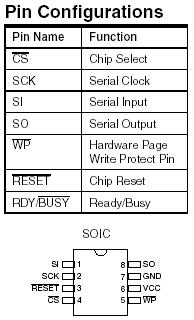Features: • Single 2.7V - 3.6V Supply
• Serial Peripheral Interface (SPI) Compatible
• 20 MHz Max Clock Frequency
• Page Program Operation
Single Cycle Reprogram (Erase and Program)
512 Pages (264 Bytes/Page) Main Memory
• Supports Page and Block Erase Operations
• One 264-byte SRAM Data Buffer
• Continuous Read Capability through Entire Array
Ideal for Code Shadowing Applications
• Fast Page Program Time 7 ms Typical
• 120 µs Typical Page to Buffer Transfer Time
• Low Power Dissipation
4 mA Active Read Current Typical
2 µA CMOS Standby Current Typical
• Hardware Data Protection Feature
• 100% Compatible with AT45DB011
• Commercial and Industrial Temperature Ranges
• Green (Pb/Halide-free) Packaging OptionsPinout Specifications
Specifications
|
Temperature under Bias ............... -55°C to +125°C
Storage Temperature ................... -65°C to +150°C
All Input Voltages
(including NC Pins)
with Respect to Ground .....................-0.6V to +6.25V
All Output Voltages
with Respect to Ground ...............-0.6V to VCC + 0.6V
|
DescriptionThe AT45DB011B is a 2.7-volt only, serial interface Flash memory ideally suited for a wide variety of digital voice-, image-, program code- and data-storage applications. Its 1,081,344 bits of memory are organized as 512 pages of 264 bytes each. In addition to the main memory, the AT45DB011B also contains one SRAM data buffer of 264 bytes. The buffer allows receiving of data while a page in the main memory is being reprogrammed. EEPROM emulation (bit or byte alterability) is easily handled with a self-contained three step Read-Modify-Write operation. Unlike conventional Flash memories that are accessed randomly with multiple address lines and a parallel interface, the DataFlash uses a SPI serial interface to sequentially access its data. SPI mode 0 and mode 3 are supported. The simple serial interface facilitates hardware layout, increases system reliability, minimizes switching noise, and reduces package size and active pin count. AT45DB011B is optimized for use in many commercial and industrial applications where high density, low pin count, low voltage, and low power are essential. AT45DB011B operates at clock frequencies up to 20 MHz with a typical active read current consumption of 4 mA.
To allow for simple in-system reprogrammability, the AT45DB011B does not require high input voltages for program-ming. The device operates from a single power supply, 2.7V to 3.6V, for both the program and read operations. The AT45DB011B is enabled through the chip select pin (CS) and accessed via a three-wire interface consisting of the Serial Input (SI), Serial Output (SO), and the Serial Clock (SCK).
All programming cycles of AT45DB011B are self-timed, and no separate erase cycle is required before programming.
When AT45DB011B is shipped from Atmel, the most significant page of the memory array may not be erased. In other words, the contents of the last page may not be filled with FFH.

 AT45DB011B Data Sheet
AT45DB011B Data Sheet









